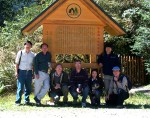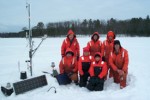Researchers in the U.S. and Taiwan have teamed up to study lake metabolism in a first-of-its-kind project using intercontinental wireless connectivity to field sensors on two sides of the Pacific Ocean. Scientists at North Temperate Lakes (NTL), the University of California San Diego (UCSD), San Diego Supercomputer Center (SDSC), the Taiwan Forestry Research Institute (TFRI), the Taiwan National Center for High-Performance Computing (NCHC), and Academia Sinica (AS) have joined forces to instrument several lakes at the NTL site in Wisconsin and Yuan-Yang Lake in Taiwan with sensors enabling measurements of gross primary production, respiration, and net ecosystem production. Wireless communication with the buoys from anywhere in the world with internet access is a prominent part of the research.
Understanding the factors influencing the carbon balance of lakes is a longstanding goal in aquatic ecology (Cole et al. 1994, Kling et al. 1991) because the carbon balance reflects both a lake’s biological activity and its links with its landscape and climatic settings. Lake metabolism can be described as the balance between the complementary processes of gross primary production (GPP) and New Wireless Sensor Network for Studying Lake Metabolism respiration (R) (Hanson et al. 2003). It is a fundamental lake characteristic that helps describe the source of carbon incorporated into all trophic levels of the ecosystem. If GPP is greater than R, then the lake is considered autotrophic and internally produces reduced carbon sufficient to fuel higher trophic levels. Alternatively, if GPP is less than R, then the lake is considered heterotrophic and must receive an external source of reduced carbon to fuel higher trophic levels. Total phosphorus (TP) and dissolved organic carbon (DOC) are two important drivers of net ecosystem production (NEP=GPP-R) in lakes (del Giorgio and Peters 1994, Hanson et al. 2003, Prairie et al. 2002). At moderate to low DOC concentrations, both GPP and R are directly related to TP.
However, when DOC concentrations are moderate to high, GPP and R are uncoupled and NEP is negative, indicating heterotrophic conditions. Previously published studies considered mostly north temperate lakes and relied on short sampling durations on individual lakes.
In the current project, lake metabolism will be measured using high frequency (~ every 10 minutes) observations of dissolved oxygen in the surface waters of lakes in Wisconsin and Taiwan. Over a diel period decrease in O2 at night will be used to calculate R. Oxygen increase during the day reflects the difference between GPP and R (Cole et al. 2000, Hanson et al. 2003).
In October 2003 Tim Kratz (NTL), Peter Arzberger (UCSD), and Bill Chang (NSF) visited Yuan Yang Lake to assess its suitability for an intercontinental comparison of lake metabolism using wireless connectivity. They met with Fang-Pang Lin (NCHC), Steven Shiau (NCHC), Grace Shau- Wei Hong (NCHC), and Chih-Yu Chiu (AS). After visiting the lake, the American contingent met with Dr. Hen-Biau King (TFRI), a co-PI on the project. Yuan Yang Lake is particularly interesting because it is a subtropical lake subject to several typhoons each year. A single typhoon can drop as much as several meters of precipitation on the 4.5 meter deep lake, causing rapid flushing of the lake. This contrasts with the Wisconsin lakes which have much longer water retention times.
In February 2004, five Taiwanese scientists, accompanied by Arzberger, traveled to the Trout Lake Station in Wisconsin to observe the metabolism buoys deployed on the NTL lakes. Drs. Fang-Pang Lin, Julian Yu-Chung Chen of NCHC, Drs. Chau-Chin Lin, Meei-Ru Jeng, and Sheng- Shan Lu of TFRI visited the NTL site. Dr. Robert Bohanan (NTL and chair of the LTER Education committee) also attended the meeting to discuss possible educational outreach opportunities presented by the wireless buoy project.
The development and deployment of wireless sensors and appropriate cyberinfrastructure will be critical to the success of the project. Yuan Yang Lake is remote and building a wireless network, beginning with a careful selection of location of radios and radio relays, to establish connectivity between the buoy on the lake and the file server system at NCHC will be a significant challenge. Secondly, software tools need to be developed to automate the movement of data from where it arrives at NCHC to a publicly accessible database. Initially we will be developing and deploying web services to publish data from NTL and Yuan Yang Lake, and developing other web services to automate the reduction of raw buoy data to estimates of daily R, GPP, and NEP. As the project matures, other services will be developed to automate aspects of the system for quality control of the data, intelligent signal detection (e.g., major external meteorological events), and automated series of analyses and visualizations. Web services, an emerging framework that integrates legacy and new IT infrastructure and software applications, builds on a set of protocols and network services for passing information between distributed endpoints of the network1 from computers to sensors (see article, page 8, this issue). Web services are being widely adopted by a global scientific and industrial community, thus providing a standard way for interfacing machines, software, and data. By providing dynamic data access and integration via web services, the system supports cross-site studies and collaborations. By basing the architecture on web services technology, the system is extensible and scalable, supporting the smooth integration of new data collections, new analytical services, and new sites and communities.
This project will leverage the buoy, sensor, and information management experiences of North Temperate Lakes2, the infrastructure and wireless experience of Ecogrid Project3 in Taiwan led by NCHC in collaboration with the Taiwan Ecological Research Network and the Taiwan Forest Research Institute, the long-term interactions between the US LTER Network and SDSC/UCSD4 in building web services, and collaborative framework and technologies of the Pacific Rim Application and Grid Middleware Assembly (PRAGMA)5 collaborating with NCHC, the Chinese Network Information Center (CNIC), the Asia-Pacific Advanced Network (APAN), and the National Agriculture Organization in Japan in building interoperating web services for meteorological data.6
We view the activities described here as developing a prototype system that, once functioning, can be expanded to more sites and be used as a model for other international collaborations that are now possible because of the technology.
Acknowledgements
This project is supported jointly by a supplemental grant from the Office of International Science and Engineering (OISE), National Science Foundation, and by funds from its counterpart agency, National Science Council of Taiwan and the Taiwan Forest Research Institute. The contact information for project funding is as follows:
- Dr. Bill Chang (wychang@nsf.gov), OISE, National Science Foundation
- Ms. Jennifer Hu (jenhu@nsc.gov.tw), National Science Council of Taiwan
- Dr. Hen-Biau King (hbking@serv.tfri.gov.tw), Taiwan Forest Research Institute
- Dr. Fang Pang Lin (fplin@nchc.org.tw), the Knowledge Innovation National Grid project, NCHC, NSC.
Literature Cited
Cole, J. J., N. F. Caraco, G. W. Kling, and T. K. Kratz. 1994. Carbon dioxide supersaturation in the surface waters of lakes. Science 265: 1568-1570.
Cole, J. C., M. L. Pace, S. R. Carpenter, and J. F. Kitchell. 2000. Persistence of net heterotrophy in lakes during nutrient addition and food web manipulations. Limnol. Oceanogr. 45: 1718-1730.
del Giorgio, P. A, and R. H. Peters. 1994. Patterns in planktonic P :R ratios in lakes: Influence of lake trophy and dissolved organic carbon. Limnol. Oceanogr. 39: 772-787.
Hanson, P. C., D. L. Bade, S. It Carpenter, and T. K. Kratz. 2003. Lake metabolism: Relationships with dissolved organic carbon and phosphorus. Limnol. Oceanogr. 48: 1112-1119.
Kling, G. W., G. W. Kipphut, and M. C. Miller. 1991. Arctic lakes and streams as gas conduits to the atmosphere: Implications for tundra carbon budgets. Science 251: 298-301.
Prairie, Y. T., D. F. Bird, and J. J. Cole. 2002. The summer metabolic balance in the epilimnion of southeastern Quebec lakes. Limnology and Oceanography 47:316-321.
Notes
- http://www.extension.ucsd.edu/Programs/index.cfm?vAction=certDetail&CertificatelD=6
- See Environmental Cyberinfrastructure Needs for Distributed Sensor Networks, Estrin, D., Michener, M., Bonito, G. http://www.lternet.edu/sensor_report/cyberRforWeb.pdf, Box 10, page 53 (or Biosciences Article - Jan 2003)
- http://ecogrid.nchc.org.tw/
- http://www.iigee.org
- http://www.pragma-grid.net, PRAGMA is supported by the National Science Foundation (Grant No. INT-0216895 and INT-0314015), its 20 member institutions.
- See http://intranet.lternet.edu/archives/documents/Newsletters/DataBits/03spring/#3fa
Additional references
- NCHC, http://www.nchc.org.tw
- CNIC, http://www.cnic.ac.cn
- NARC, http://narc.naro.affrc.go.jp/narc-e/index.html
- MetBroker, http://www.agmodel.org/index.html.en

 Enlarge this image
Enlarge this image
